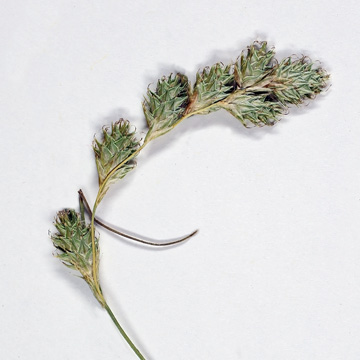

Carex argyrantha - (image 1 of 5)
Taxonomy
Family: Cyperaceae
Section Ovales
Habitat
Open woods and clearings, typically in dry, sandy or rocky soil.
Associates
Distribution
Nova Scotia and New Brunswick to VA, west to southern Quebec, southern Ontario, OH, and MI.
Morphology
Tufted perennial to 1 m; aphyllopodic; leaves 3-5 mm wide, shorter than stems, bracts inconspicuous; spikes 3-15, gynaecandrous, 6-25 mm, sessile in a loose, often lax spike that is sometimes interrupted below; pistillate scales about as long as the perigynia; perigynia planoconvex, finely granular-papillose, 3.1-4.2 mm long and 1.2-2.2 mm wide, strongly and evenly (4)5-8(-10)-nerved on both faces, widest at or just above the middle, beak flattened; wing-margins expanded above the middle of the body, coarsely and irregularly serrulate or erose-ciliolate; achene lenticular, 1.5-2 mm; stigmas 2.
Notes
Fruiting June to July
Wetland indicator: NA
One of a small number of species in the section Ovales that have pistillate scales about as long as the perigynia and also wide enough at the tip that they largely cover the perigynium beak (though often narrower than the body of the perigynium). This species differs from the others in that the perigynia are whitish green at maturity, strongly nerved on both faces, finely granular-papillose, and the margin serrulose-winged near the junction of the body and the beak.
References
Ball, P.W. and A.A. Reznicek. 2002. Carex, In: Flora of North America Editorial Committee, Eds. Flora of North America North of Mexico. Volume 23. Oxford University Press, New York.
Gleason, Henry A. and A. Cronquist. 1991. Manual of Vascular Plants of
Northeastern United States and Adjacent Canada. Second Ed.
The New York Botanical Garden. Bronx, NY
|
© Michael Hough 2018 |